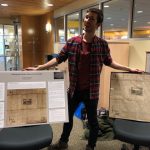December was a fairly eventful month for us. November went out with a bang (a real one, a 7.0 earthquake with an epicenter very near Anchorage) and so our regular workload for early December was rewritten by needing to deal with the aftermath of the effects of shaking on a building and shelving units. Gwen and Veronica managed to clean up the over 130 boxes that landed on the floor of our archives vault (or on the other boxes, really) in just about 8 hours of work. Arlene picked up the oversize books in Rare and Susan Klein, a local librarian, came in and helped us out by picking up the APU theses that had fallen and getting all of them in call number order and boxed for storage in the vault. Thanks Susan! We also did a few days of book and journal pickup in the other sections of the library too. We did a recap of our experiences with the quake in our December podcast and took a look at how compact shelving might have helped us have a different outcome in our blog. Thankfully none of the many aftershocks have caused any additional damage to collections or the facility, though we all seem to be a bit jumpy about some of the larger ones.
Processing:
Here’s the collections and additions to collections that we described and prepared for access this month:
EPH-0416: Order of the Walrus certificate and pin; circa 1960-1969. 0.01 cubic feet.

HMC-1300: Craig Mishler papers; 1943-2015, bulk 1988-1998. 3 cubic feet. Papers from a folklorist and anthropologist.
HMC-1309: Chickaloon Coal Company records; 1910-1922, bulk 1917-1919. Documents regarding company operations.
HMC-1180: Walter Parker papers; circa 1940-2014. 6.1 GB Digital versions of documents that due to fire damage could not be saved.
HMC-0059: Clarence Leroy Andrews papers; 1892-1946, addition of 0.75 cubic feet, glass lantern slides.
Events:
We hosted the poster session for Dr. Jennifer Stone’s History of the English Language course final. It’s always such a treat to see the use students are making of archival sources! Here’s a few photos of some of the projects and if you’re interested in learning more about how this topic can connect with archival sources, Gwen interviewed Dr. Stone for our podcast in November.
Alaska’s Digital Archives
Technically it was in November that the Alaska’s Digital Archives was moved to a new hosting platform, but it was December when we finally got the access to the administration of the site and could start updating items and adding more. It’s not the prettiest looking thing at the moment and there’s a few bits of customization that we’d gotten used to that are no longer available, but overall there are a lot of benefits to this change, especially once we get some work done on how the site looks. For starters, the site is now a responsive design which means that for folks working on mobile devices like smart phones and tablets, they’ll have an easier time viewing the site because it will be resized to fit their screens. One behind the scenes benefit, which you might not be aware of, is the substantial costs savings and access to software upgrades. Due to how we’d been running the site, we no longer had access to software support which meant that a lot of software upgrades and bug fixes–like that responsive design–were not available to us. On the cost side, while each partner still absorbs the cost of digitizing, cataloging, uploading, and updating each individual item in the Digital Archives, our joint costs for software and server support and administration have been cut by well over half: from about $65,000 per year to just under $30,000 for the next year and we expect it to decrease even more in following years. That’s a huge cost savings to the three partners that pay for site maintenance (Alaska State Library, UAA/APU Consortium Library, and UAF Rasmuson Library) and will hopefully mean that sustaining partnerships will become more financially viable for some of our current partners who have been participating on a smaller level with limited term project partnerships. If you’ve been using the site in past and can’t find some functionality that you used to have, will you let us know? We’ll see if we can figure out if it can be re-established or if not, if there’s a different way of doing the same thing.
In the meantime, we’ve started working again to upload more items to the Digital Archives. For December, that was 14 additional images from the Clarence Leroy Andrews papers.
That’s it for December and 2018 too. We’re looking forward to another productive year but hope that won’t include any new substantial earthquake responses! We wish you all the best for 2019.









